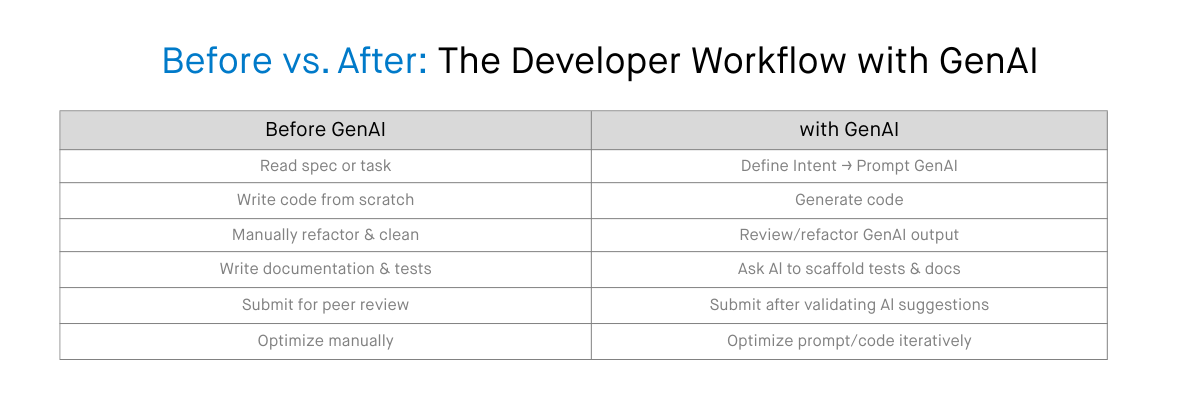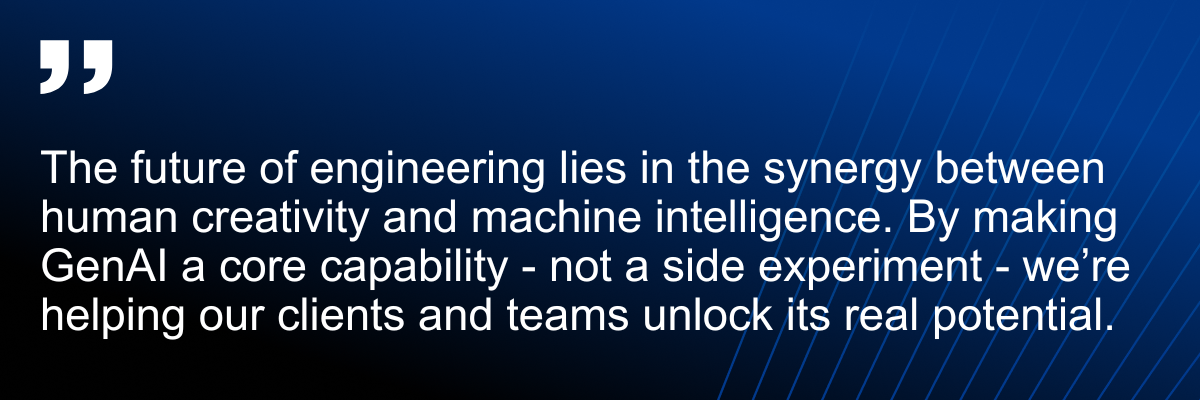In my ongoing work helping teams evolve their engineering practices, I’ve been closely tracking the impact of generative AI on software development workflows. We’re not just witnessing productivity gains, we’re entering a new paradigm where code assistants become active collaborators in design, debugging, and delivery. This shift demands not only new tools, but a rethinking of how we structure teams, measure output, and approach the craft of software itself.
I believe this change marks a significant turning point in how we build, collaborate, and think about code.
The Path Forward for Software Development Practices
In our recent article, How AI Is Redefining the Role of the Software Engineer, we explored how generative AI is beginning to transform the developer role–from writing and reviewing code to testing and deploying software. This exciting evolution, far from automating engineers out of a job, is about fundamentally changing how they approach their craft. In this follow-up, we go deeper into a core outcome of that transformation: the new GenAI-powered developer workflow.
Over the past year, a growing number of engineers have incorporated tools like Cursor, GitHub Copilot, and Claude, among others, into their daily work. But beyond individual usage, engineering leaders are starting to ask: What does a GenAI-native software development process look like? How should we evolve our engineering practices to take full advantage of these tools?
A Shift in the Way Software Gets Built
Traditionally, software development has followed a linear or iterative cycle: gather requirements, write code, test, deploy, and maintain. Developers were expected to be the sole authors of every line of code they produced. While collaboration and pair programming existed, the cognitive load remained largely individual.
.png)
With GenAI, that model is shifting. Code assistants are now part of the team–non-human collaborators that can generate boilerplate, suggest optimizations, write tests, translate code, and more. Developers are moving from "code authors" to "code curators", reviewing, editing, and assembling code that is initially produced by AI.
The changes go beyond individuals. As teams adopt GenAI-powered workflows, we observe new norms emerging:
- Pair programming with AI becomes common, where junior and senior developers alike benefit from AI suggestions without waiting for human feedback cycles.
- Knowledge silos are reduced, as AI assistants surface internal documentation, reusable components, or historical rationale for technical decisions.
- Onboarding accelerates, since new developers can quickly understand legacy systems or unfamiliar stacks through contextual explanations from AI tools.
Engineering culture is adapting to embrace curiosity, iteration, and critical thinking.
This new paradigm is already reshaping development workflows:
- Problem-to-code translation is faster. Developers spend less time writing syntax and more time framing prompts and defining solutions.
- Code reviews start earlier. Since AI can generate partial solutions quickly, team members can collaborate and validate directions before full implementation.
- Test coverage improves. GenAI tools are helping teams write comprehensive test suites as they go, not as an afterthought.
- Documentation is less painful. Auto-generated docs based on code and prompts are reducing friction.
Visual 1: Before vs. After – The Developer Workflow

From Adoption to Enablement: A Strategic Shift
Many teams remain in the exploratory stage – testing assistants in side projects or internal tools. However, leading organizations are formalizing their adoption. They’re defining governance, establishing ethical guidelines, integrating assistants with source control, and tracking impact.
At intive, we’re not just experimenting with these tools – we’re redefining our engineering enablement strategy around them. We’ve committed to a long-term strategy that places GenAI at the core of our engineering evolution. Our program is built on four strategic drivers:
- Capability Development – We’re embedding GenAI training into our onboarding and continuous learning programs. Every developer, regardless of seniority, will have access to resources that help them responsibly and effectively use GenAI tools.
- Tooling and Enablement – We are curating a suite of GenAI tools and integrating them securely into our development environments, ensuring data privacy, IP protection, and performance.
- Measurement and Impact Tracking – A dedicated dashboard helps us track GenAI adoption across teams, gather developer sentiment (NPS), and identify areas for further optimization, among other things.
- Community and Innovation Hubs – Through our internal Hubs (AI, Cloud, Mobile, QA, SE Excellence, and Incubator), we host sessions, run internal POCs, and share insights on the most effective AI use cases in software engineering.
This strategic program reflects our belief that the future of engineering lies in the synergy between human creativity and machine intelligence. By making GenAI a core capability – not a side experiment – we’re helping our clients and teams unlock its real potential.

The Road Ahead
We are still in the early days of this transition, but the changes are already profound. Developers who embrace these tools are finding new ways to express solutions, accelerate feedback loops, and improve quality. Engineering leaders are rethinking team roles, metrics, and onboarding.
As we continue to evolve our software engineering practices, we believe the future won’t belong to those who simply code faster – it will belong to those who collaborate better with AI.
Want to learn more about how intive is helping clients and teams evolve their developer workflows with GenAI? Let’s connect.





.png)
